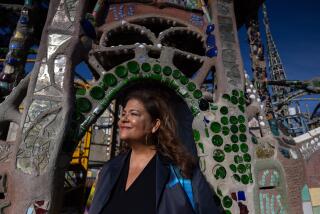The Smithsonian’s lost integrity
- Share via
On Monday, the Smithsonian Institution’s board of regents holds its first meeting since Secretary G. Wayne Clough pulled a controversial video artwork out of an exhibition at the National Portrait Gallery. It was a blatant act of censorship and a betrayal of the institution’s mission. Now the question is, can Clough be an effective leader given the damage he’s done?
Clough’s problems began in November when he ordered the removal of a short, edited passage of David Wojnarowicz’s 1987 video, “A Fire in My Belly” from “Hide/Seek: Difference and Desire in American Portraiture.” The show reveals how gay and lesbian artists first developed many of the styles and modes of presentation that are now synonymous with American art.
Wojnarowicz’s excerpted video, which refers to loss, inequality, faith and desire, and was made just after the artist was diagnosed with HIV, included brief footage of ants crawling on a figure of Christ on a crucifix.
Clough removed the video when the right-wing Catholic League complained that the work was anti-Christian “hate speech” and after the Republican leadership in the House of Representatives piled on. The Smithsonian receives about two-thirds of its funding from the federal government.
Clough’s act of censorship quickly prompted howls of protest. The Assn. of Art Museum Directors said that the withdrawal of the work “undermines the principles ... on which our nation was founded.” A prominent foundation announced it would not fund exhibitions at the Smithsonian unless “A Fire in My Belly” was returned to the exhibition. More important, dozens of art museums raced to show the full Wojnarowicz artwork and encouraged the dialogue about the work that Clough’s action precluded at the Smithsonian. In a particularly pointed rebuke, the Museum of Modern Art acquired “A Fire in My Belly” for its collection.
When Clough finally spoke, 49 days after he censored “Hide/Seek,” he was hardly repentant.
“I think I made the right decision,” he told the New York Times. In the Los Angeles Times, he sounded a bit more circumspect. “It was the most painful thing I’ve ever done,” he said. Clough claimed that potential threats to the institution’s funding were a factor, as was the possibility of a “hullabaloo” and the “devastating impact” of similar episodes in the past.
Clough didn’t say “I was wrong.” Nor did he face up to his own act’s devastating impact on the Smithsonian.
Clough has claimed that the Wojnarowicz video wasn’t important to “Hide/Seek.” (“Hardly anyone was looking at it,” he told the L.A. Times.) But the exhibition’s curators, who must ruthlessly edit what goes on display, presented it as an important evocation of the way America initially shrugged at the AIDS epidemic. Once the work was on view, it was the Smithsonian’s job to explain why it was chosen.
When the Catholic League asserted that the Wojnarowicz work was anti-religious, Clough could have pointed out that ants are a centuries-old artistic symbol conveying the frailty of life and that artists have long used images of Christ’s suffering as a metaphor for human pain. If the Wojnarowicz work is anti-Catholic, so is much of the last millennium of Christian art. Clough apparently feared and certainly avoided a conversation that the head of the Smithsonian should have embraced.
That’s all unfortunate and merits consideration, but none of it is dismissal-worthy. Instead, Clough’s job is at issue because his actions have damaged the Smithsonian’s ability to carry out its mission: “the increase and diffusion of knowledge.” Here’s why:
Good art museum exhibitions are not merely the presentation of aesthetically pleasing things. Instead, they reveal the story of an artist, a group of artists, a time period or, in the best examples, the relationship between art and a broader social or political history. “Hide/Seek” accomplished that.
When Clough removed the Wojnarowicz video from “Hide/Seek,” he took the process of researching and explaining history away from scholars and curators and handed it over to activists with a record of objecting to the inclusion of certain voices and people in our nation’s cultural history. The Catholic League, which has no official connection with the Catholic Church, has a long history of anti-gay statements. Among the Catholic League’s advisory board members is anti-gay activist L. Brent Bozell III, whose propagandist CNSNews.com ginned up the right-wing response to the exhibition.
Just as bad, Clough sent a chilling message to the rest of the scholars and scientists at the Smithsonian: If you research the most challenging parts of our nation’s past, the Smithsonian’s leadership may not support you.
Historians, researchers and curators at our national museums must be able to examine all of our history with determination, fearlessness and fealty to the facts. Clough’s actions have ensured that every Smithsonian curator will wonder which facts they can present before he will find the truth inconvenient. As long as Clough leads the Smithsonian, the institution’s curators cannot produce history and conduct research without wondering if their work will become politically expendable.
To restore integrity to the Smithsonian’s work, Clough must go.
Tyler Green reports and edits the website Modern Art Notes and is the U.S. columnist for Modern Painters magazine.
More to Read
A cure for the common opinion
Get thought-provoking perspectives with our weekly newsletter.
You may occasionally receive promotional content from the Los Angeles Times.






